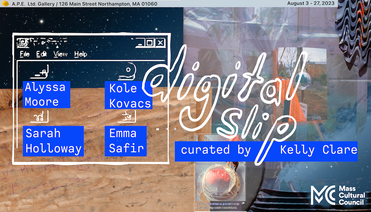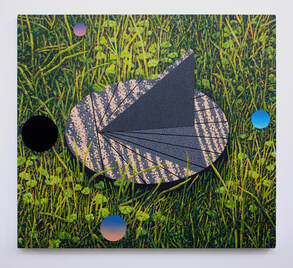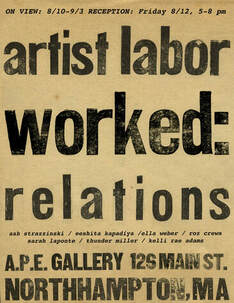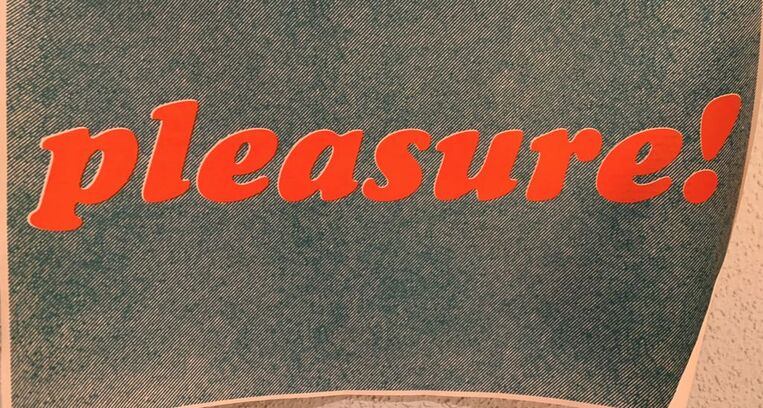GUEST CURATOR PROGRAM
An important focus for A.P.E. is to provide access and visibility to both emerging and established artists within Northampton and beyond. Our Guest Curator Program gives contemporary artists and curators more agency in the curatorial process. A.P.E.'s Guest Curator selection committee will select 2 curators per year who facilitate and assemble exhibitions from local, regional, and national arts communities. Every exhibition must include at least one mid-career regional (Massachusetts or greater New England) artist 35 or older. We do this to give a more prominent voice to artists of our region, while creating a conversation with contemporary artists from farther away. These exhibitions range in approach and media and are interspersed throughout A.P.E.'s exhibition season.
The 2024 selection committee includes Grace Clark, AJ Rombach, Ash Strazzinski, Zoe Sasson, with Kathy Couch and Lisa Thompson from A.P.E.
If you would like to apply for the Guest Curator Program, please visit our submissions page for more information.
If you are interested in supporting this program, you can make a donation HERE
The 2024 selection committee includes Grace Clark, AJ Rombach, Ash Strazzinski, Zoe Sasson, with Kathy Couch and Lisa Thompson from A.P.E.
If you would like to apply for the Guest Curator Program, please visit our submissions page for more information.
If you are interested in supporting this program, you can make a donation HERE
Guest Curator Exhibitions
2023

digital slip
Curated by Kelly Clare
August 3 - 27, 2023
digital slip brought together four artists--Alyssa Moore, Sarah Holloway, Kole Kovacs, and Emma Safir—to consider the human aspects of our digital infrastructures. As infographics rebel and a keyboard morphs into woodgrain, viewers are invited to consider how they can reimagine their own relationships with both hardware and software.
Curated by Kelly Clare
August 3 - 27, 2023
digital slip brought together four artists--Alyssa Moore, Sarah Holloway, Kole Kovacs, and Emma Safir—to consider the human aspects of our digital infrastructures. As infographics rebel and a keyboard morphs into woodgrain, viewers are invited to consider how they can reimagine their own relationships with both hardware and software.
2022
 David Aipperspach, Sundial (3), 36" x 40", oil on canvas, 2022.
David Aipperspach, Sundial (3), 36" x 40", oil on canvas, 2022.
SHADOW WORK
Curated by AJ Rombach
October 14 - November 6, 2022
SHADOW WORK examined painting's potential to trace the cognitive and unconscious thought of maker and viewer. What does a symbol communicate? How do paintings act as bridges between subjective and collective experience? How do art objects encapsulate ontological mystery? SHADOW WORK aimed to create an environment in which the unconscious be permitted to (consciously) surface.
Curated by AJ Rombach
October 14 - November 6, 2022
SHADOW WORK examined painting's potential to trace the cognitive and unconscious thought of maker and viewer. What does a symbol communicate? How do paintings act as bridges between subjective and collective experience? How do art objects encapsulate ontological mystery? SHADOW WORK aimed to create an environment in which the unconscious be permitted to (consciously) surface.

Worked: Artist Labor Relations
Curated by Grace Clark
August 10 - September 3, 2022
Worked: Artist Labor Relations, was an exhibition of 7 innovative artists working in painting, printmaking, video, performance, sculpture, installation, social practice, and combined media.
Artists often have a unique relationship with work, as they, themselves, have the privilege of determining the labor that consequently makes up their practice. However, many artists’ practices can be heavily influenced by the financial need to work additional full-time jobs. How do artists lean into balancing this obligation and desire? Worked explores how artists respond to their relationship with labor––through critical discourse, radical rest, and intentional play––to consider the many shapes that labor can take.
Curated by Grace Clark
August 10 - September 3, 2022
Worked: Artist Labor Relations, was an exhibition of 7 innovative artists working in painting, printmaking, video, performance, sculpture, installation, social practice, and combined media.
Artists often have a unique relationship with work, as they, themselves, have the privilege of determining the labor that consequently makes up their practice. However, many artists’ practices can be heavily influenced by the financial need to work additional full-time jobs. How do artists lean into balancing this obligation and desire? Worked explores how artists respond to their relationship with labor––through critical discourse, radical rest, and intentional play––to consider the many shapes that labor can take.

Wanna Come Over?
curated by Aidan Wright and Ariella Heise
April 5 - 24, 2022
Wanna come over? was a group installation piece at A.P.E. gallery led by art students at Smith College. Working in collaboration, the senior class students (both Art History and Studio Art majors) sought to recreate the space of a Smith dorm room. Using the classic school-chosen furniture as well as trinkets, textiles, wall art, doodles, and more, this room represents the inner spaces of student life as they contrast the elusive exteriors of a private institution.
curated by Aidan Wright and Ariella Heise
April 5 - 24, 2022
Wanna come over? was a group installation piece at A.P.E. gallery led by art students at Smith College. Working in collaboration, the senior class students (both Art History and Studio Art majors) sought to recreate the space of a Smith dorm room. Using the classic school-chosen furniture as well as trinkets, textiles, wall art, doodles, and more, this room represents the inner spaces of student life as they contrast the elusive exteriors of a private institution.
